
ParvatiUma or Gauri is the Hindu goddess of power, energy, nourishment, harmony, love, beauty, devotion, and motherhood. In her complete form, she is a physical representation of Mahadevi also known as Adi Shakti, the primordial power behind the creation of the universe, the creator and destroyer. She is one of the central deities of the goddess-oriented sect called Shaktism, and the supreme goddess in Shaivism. Along with Lakshmi and Sarasvati, she forms the Tridevi.

Uthamar Kovil in Uthamarkoil, a village in the outskirts of Tiruchirappalli in the South Indian state of Tamil Nadu, is dedicated to the Hindu Trimurti of Vishnu, Shiva, and Brahma. Constructed in the Dravidian style of architecture, the temple is glorified in the Nalayira Divya Prabandham, the early medieval Tamil canon of the Alvar saints from the 6th–9th centuries CE. It is one of the 108 Divya Desams dedicated to Vishnu, who is worshipped as Purushothaman Perumal and his consort Lakshmi as Poornavalli Thayar.
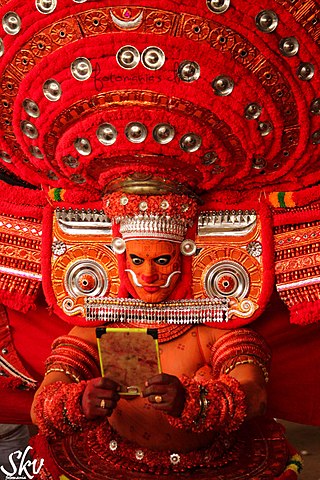
Theyyam is a Hindu religious ritual practiced in northern Kerala and some parts of Karnataka. Theyyam is also known as Kaḷiyāṭṭaṁ or Tiṟa. Theyyam consists of traditions, rituals and customs associated with temples and sacred groves of Malabar. The people of the region consider Theyyam itself as a channel to a god and they thus seek blessings from Theyyam.
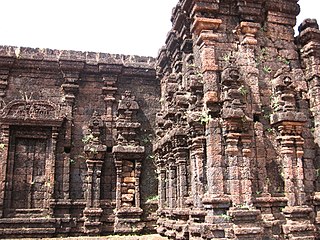
The Rajarajeshwara temple is a Shiva temple located in Taliparamba in Kannur district of Kerala State of India. The temple is regarded as one of the existing 108 ancient Shiva Temples of ancient Kerala. It also has a prominent place amongst the numerous Shiva temples in South India. It had the tallest shikhara amongst the temples of its time. The Rajarajeshwara temple has a top of about 90 tonnes. If any problem is encountered in the other temples of South India, devotees seek a solution in this temple through a prashnam, a traditional method of astrological decision-making. The prashnam is conducted on a peedha outside the temple.
Azhakodi Devi Temple or Azhakodi Devi Mahakshethram is a Hindu temple located in Thiruthiyad, Kozhikode District, Kerala, South India. It is one of the famous Devi temples, situated hardly 1.5 km away from the Mofussil Bus stand and 2.5 km from the KSRTC Bus stand, the area still retains the beauty and charm of un-spoilt rural settings within the heart of the Kozhikode city. The temple and the Kalayana Mandapom are administered by the Malabar Devaswom Board.

Bhadrakali is a Hindu goddess. She is considered to be the auspicious and fortunate form of Adi Shakti who protects the good, known as bhadra.
Edakkad is part of the Kannur Municipal Corporation in Kannur District of Kerala state, in India.

Bhagavatī, is an Indian epithet of Sanskrit origin, used as an honorific title for goddesses in Hinduism and Buddhism. In Hinduism, it is primarily used to address the goddesses Durga and Lakshmi. In Buddhism, it is used to refer to several Mahayana Buddhist female deities, like Cundā.

Thirumandhamkunnu Temple is a historically significant Hindu temple in Angadipuram, which was the capital of Valluvanad Rajavamsham, in Malappuram district, Kerala state, South India. The temple deity, Thirumandhamkunnil amma, was the paradevatha of the kings of Valluvanad, the local feudal kings ruled the area in the Middle Ages. The Nair warriors of Valluvanad king set out from this temple to Thirunavaya, to participate in the famous Mamankam festival. A memorial structure called the chaver thara can be found in front of the main entrance of the Thirumanthamkunnu Temple.

The Kodikkunnu Bhagavathy Temple or Kodikkunnu Ambalam is a Hindu temple dedicated to the goddess Durga located in the village of Pallippuram, near Pattambi, in Palakkad district of Kerala, India.

Thiruvarkadu Bhagavathi Temple is the mother temple of all Bhadrakali shrines of Kerala. The deity is the Fierce form of Bhadrakali. The Bhagavathy is addressed by tantrics in the vicinity as Tiruvarkkad Achchi due to this. The temple administration is Malabar Devaswom Board. The temple is a revered shrine of Chirakkal Royal Family and a shrine of Chirakkal devaswom before. The temple is situated in Madayi, Payangadi, hence prominently known as Madayi Kavu.
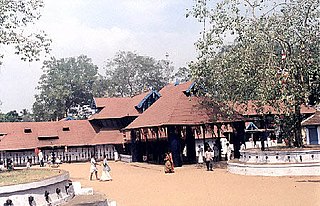
Sree Kurumba Bhagavati Temple is a Hindu temple at Kodungallur, Thrissur District, Kerala state, India. It is dedicated to the goddess Bhadrakali, a form of Mahakali or simply Durga or Aadi Parashakthi worshipped and significantly revered in Kerala. The goddess is known also by the names "Sri Kurumba"". This temple is the head of 64 Bhadrakali temples in Kerala. This Mahakali temple is one of the oldest functioning temples in India. This is attested by numerous Tamil poems and inscriptions of different times. The goddess of the temple represents the goddess in her fierce ('ugra') form, facing North, featuring eight hands with various attributes. One is holding the head of the demon king Daruka, another a sickle-shaped sword, next an anklet, another a bell, among others. Routine worship at the temple every day at 03:00 and ends at 21:00 local time.
Kuttumuck Siva Temple, the abode of Lord Kuttumuck Sree Mahadevan, is located about 5 km northeast of Thrissur. According to the legends, the idol worshipped here is more than 300 years old. But there are no historical records to establish it. The name 'Kuttumuck' is believed to have evolved from Kutti Muck.
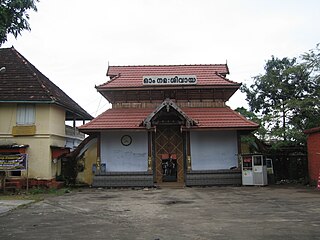
Ernakulam Shiva Temple, also known as Ernakulathappan Temple is one of the major temples of Kerala, located in heart of Ernakulam, Kochi,Kerala, India. The temple, dedicated to Lord Shiva, is considered as the city temple, with the presiding deity as the protector of the city, as per local Hindu faiths and traditions. As per the common practice in Kerala, the deity is reverently called Ernakulathappan, which means Lord of Ernakulam. The temple is located within the Durbar Hall Ground. The temple history itself has deep association with history of the city and was one of the 7 royal temples of Kochi Maharajas. The temple is now under administration of Cochin Devaswam Board. The temple in its current form was built under active patronage of Diwan Sri Edakkunni Sankara Warrier in year 1846 and raised it level of a Royal temple in the Kochi Kingdom. The temple is built on 1-acre (4,000 m2) land. The temple is one of the major Shiva temples in Kerala counted along with the Ettumanoor Mahadevar Temple, Kaduthruthy Mahadeva Temple, Vaikom Temple, Chengannur Mahadeva Temple, Vadakkunathan temple, and Sreekanteswaram Mahadeva Temple, Thiruvananthapuram.
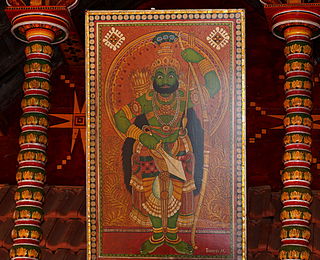
Vettakkoru Makan is a Hindu deity worshipped in parts of Northern Kerala. This deity is alternately referred as Kiratha-Sunu in Sanskrit. Vettakkorumakan is believed to be the son of Shiva by his consort Parvati, born when he assumed the form of a Kirata (hunter) to deliver a weapon known as Pashupatastra to Arjuna. He is mostly and exclusively worshipped in Malabar region of Kerala. The most famous temple of this deity is the Balussery-Kotta Vettakkorumakan temple about 25 km from Calicut. This was once the fort of the Rajas of Kurumbranad. Other prominent temples are at Ramanthali, Nileshwar, Kottakkal, Nilambur, Karaparamba and various places in Kannur district and Kasargod district. He is the family deity of the Rajas of Chirakkal, Nileshwar, Kottakkal, Nilambur Kovilakam, Kalathil Kartha's, Aluva, Amarambalam Kovilakam and Randu Illam Vargam Nambiars. Those families among the nobility of Malabar who have Vettakkorumakan as their family deity are connected in one way or other incidentally to either Balussery Fort or Kurumbranad.Later he moved to Kottanachery temple in Vellur, Payyanur in North Malabar. A special type of firecracker called "Kathina" was his favourite.

Sree Valayanad Devi Temple dedicated to Bhagavathy, is situated in Valayanad near Kozhikode in North Kerala, India.
Palkulangara Devi Temple is a Hindu temple in Palkulangara, Thiruvananthapuram, Kerala, India. This place is around 1 km from Pettah junction, 700 m from West Fort junction and 1.5 km from Chakka bypass junction. It is about 1.5 kilometres to the west of Sree Padmanabhaswamy Temple in Thiruvananthapuram city. Now the temple is under the control of Sree Palkulangara Devi Temple Trust. The temple is an excellent example of Kerala Vasthu Vidya. The abode of Sree Palkulangara Devi is one of the most ancient temples in Kerala, which preserves the beauty and atmosphere gifted by nature. A kavu is also there in the temple.
Andoor Kandan Sree Dharma Sastha Temple is one of the renowned Sastha Temples in south Kerala. It is situated 13 km east of Neyyattinkara i.e. 32 km south-east of Thiruvananthapuram, Kerala. The God Kandan Sree Dharma Sastha is the main deity of this temple. It is considered to be one of the rarest temples in Kerala having the God Sastha facing the west.
The Changattu Bhagavathy Temple is a Hindu religious shrine at Kallambalam in Kerala, India. The Goddess Kannaki (Parvathi) is the main deity in this temple.














